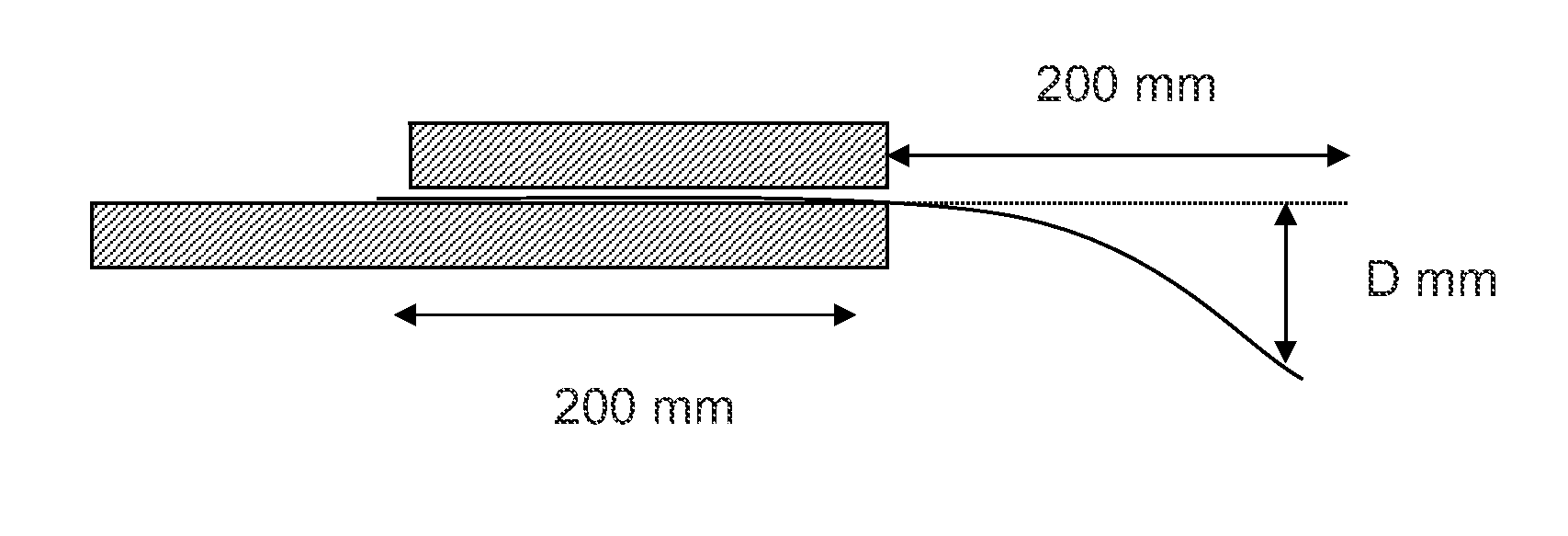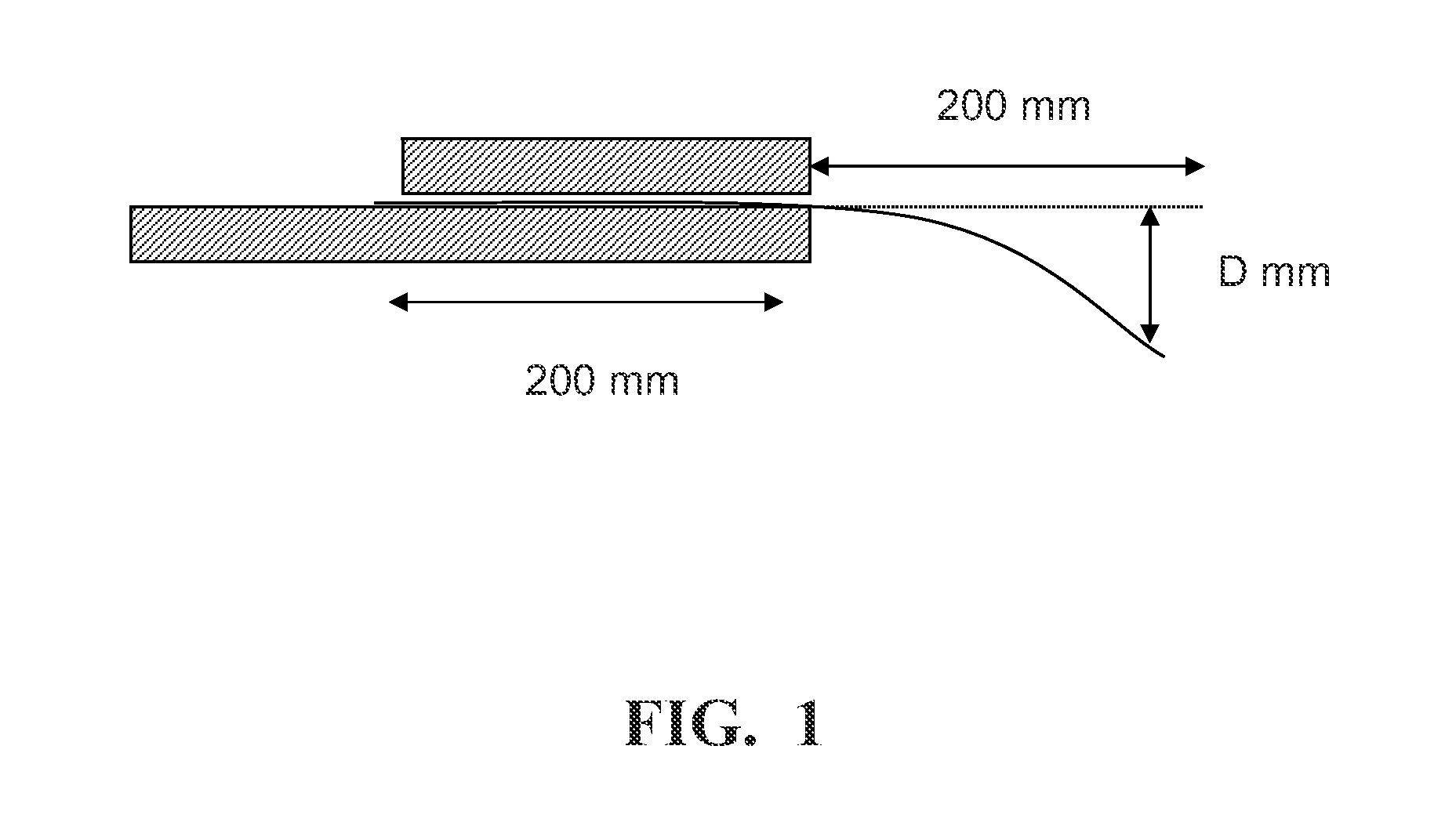Enhanced Flexible Lightweight Ballistic, Stab and Spike resistant Materials
a technology of energy absorption and ballistics, applied in protective equipment, transportation and packaging, weapons, etc., can solve the problems of fibers that cannot be pushed apart by thin weapons, can not be used in sharp and thin weapons such as knives and ice-pickles, and reduce the ability of fibers to mov
- Summary
- Abstract
- Description
- Claims
- Application Information
AI Technical Summary
Benefits of technology
Problems solved by technology
Method used
Image
Examples
example 2
[0098]Poly-p-phenylene terephtalamide yarns having a linear density of 1100 dtex were woven into a plain weave fabric having 8.5 ends / cm (warp) and 8.5 ends / cm (weft) and were subsequently laminated with a total of two ionomer blown films having a thickness of 55 μm, by laminating one ionomer film onto each side of the fabric, to yield a laminated para-aramid woven layer.
[0099]The ionomer was a copolymer of ethylene and 19 wt-% MAA (methacrylic acid), wherein 45% of the available carboxylic acid moieties were neutralized with sodium cations and having melting point of 98° C. (product supplied by E. I. du Pont de Nemours and Company, Wilmington, Del. under the trademark Surlyn®).
[0100]23 layers of para-aramid laminated fabric where freely assembled together by stacking them and inserting the stack into a pouch having one 3 mm thick backing layer made of PU foams having an areal density of 100 g / m2 to form a multilayered pack having a total areal density of 6.556 kg / m2. The multilayer...
example 3
[0101]Preparation of a Laminated Para-aramid Woven Layer
[0102]Poly-p-phenylene terephtalamide yarns having a linear density of 1100 dtex were woven into a plain weave fabric having 8.5 ends / cm (warp) and 8.5 ends / cm (weft) and were subsequently laminated with a Nylon / Ionomer blown film having a thickness of 55 μm to yield a laminated para-aramid woven layer.
[0103]The Nylon / Ionomer having a melting point of 178° C. film was composed of 55% Nylon 12 by weight, commercially available from Arkema under the trademark Rilsan AESNO and having a melting point of 180° C., and of 45% by weight of a zinc ionomer having a melting point of 95° C. and having a neutralisation percentage of 60% and composed of ethylene (83% by weight) , methacrylic (11% by weight) acid and maleic acid anhydride (6% by weight), based on the weight of the thermoplastic composition. 30 layers of para-aramid laminated fabric where freely assembled together by stacking them and inserting the stack into a pouch having on...
example 4
[0104]Poly-p-phenylene terephtalamide yarns having a linear density of 1100 dtex were woven into a plain weave fabric having 8.5 ends / cm (warp) and 8.5 ends / cm (weft) and were subsequently laminated with of two Nylon / Ionomer blown films having a thickness of 55 μm, by laminating one ionomer film onto each side of the fabric, to yield a laminated para-aramid woven layer.
[0105]The Nylon / ionomer having a melting point of 178° C. film was composed of 55% Nylon 12 by weight, commercially available from Arkema under the trademark Rilsan AESNO and having a melting point of 180° C., and of 45% by weight of a zinc ionomer having a melting point of 95° C. and having a neutralisation percentage of 60% and composed of ethylene (83% by weight) , methacrylic (11% by weight) acid and maleic acid anhydride (6% by weight), based on the weight of the thermoplastic composition.
[0106]23 layers of para-aramid laminated fabric where freely assembled together by stacking them and inserting the stack into ...
PUM
| Property | Measurement | Unit |
|---|---|---|
| diameter | aaaaa | aaaaa |
| diameter | aaaaa | aaaaa |
| diameter | aaaaa | aaaaa |
Abstract
Description
Claims
Application Information
 Login to View More
Login to View More - R&D
- Intellectual Property
- Life Sciences
- Materials
- Tech Scout
- Unparalleled Data Quality
- Higher Quality Content
- 60% Fewer Hallucinations
Browse by: Latest US Patents, China's latest patents, Technical Efficacy Thesaurus, Application Domain, Technology Topic, Popular Technical Reports.
© 2025 PatSnap. All rights reserved.Legal|Privacy policy|Modern Slavery Act Transparency Statement|Sitemap|About US| Contact US: help@patsnap.com


